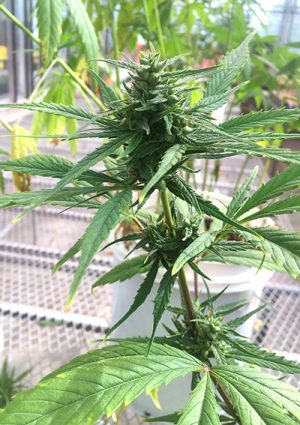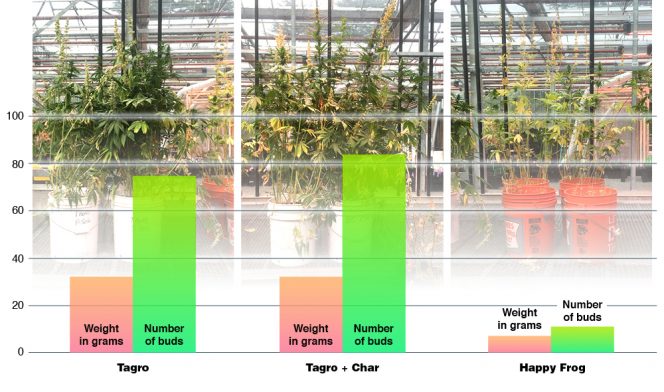Sally Brown
Growing cannabis is now a legal business in a majority of the U.S. and all of Canada. Sales in Washington State (one of 10 where recreational use is legal and one of 7 where sales are taxed) in 2018 totaled $534 million. By comparison, according to the U.S. Department of Agriculture’s Economic Research Service, the turfgrass industry in the U.S. is a $40 billion industry. Kentucky blue grass typically depends on high rates of N, P and K as well as irrigation to keep lawns green and lush.
 As currently grown, Kush (a cannabis strain, rhymes with lush) also depends on high rates of fertilizers and irrigation water to keep plants green and buds big. Cannabis is often grown indoors under artificial light. Diseases are of paramount concern and so herbicide and pesticide use is common. Cannabis cultivation is also concentrated. Whereas turfgrass covers about 50 million acres, cannabis cultivation is done on a much smaller land base — likely with a much higher environmental footprint. That is where we come in. Years of research have shown that growing turfgrass with compost- and biosolids-based soil products gives you a green and lush lawn with a low carbon and water footprint. We can do the same thing for the cannabis industry.
As currently grown, Kush (a cannabis strain, rhymes with lush) also depends on high rates of fertilizers and irrigation water to keep plants green and buds big. Cannabis is often grown indoors under artificial light. Diseases are of paramount concern and so herbicide and pesticide use is common. Cannabis cultivation is also concentrated. Whereas turfgrass covers about 50 million acres, cannabis cultivation is done on a much smaller land base — likely with a much higher environmental footprint. That is where we come in. Years of research have shown that growing turfgrass with compost- and biosolids-based soil products gives you a green and lush lawn with a low carbon and water footprint. We can do the same thing for the cannabis industry.
Much of what we know about growing lawns has come from university research. At just about any land grant university you can major in turfgrass, and get your pick of high paying jobs after graduation. The same currently can’t be said for cannabis (except for the high paying jobs). Because cannabis is still considered to be a highly dangerous drug on a federal level there is essentially no research going on in the U.S. Researchers are chomping at the bit to quantify benefits associated with medicinal use. Epidiolex, a cannabinoid based drug developed and licensed to treat a type of epilepsy, is expected to generate $1.1 billion in sales by 2020. Research in Canada, where use is legal, is still bogged down by permit requirements. An article in Science noted that there were 251 research applications waiting for approval in July 2019. What this means is that if you are waiting for a Cooperative Extension bulletin to break into the growers’ market, don’t hold your breath. Much of what we know about growing cannabis is based on anecdotal information. Good stories and minimal science.
Growth Trials
A former student, now a regulator in Indiana, interviewed growers and retailers in Washington a few years after cannabis became legal. He gleaned some basic information. Commercial growers typically grow from clones, not seed. They are very concerned with disease and typically dispose of growing media after each harvest. Plants are often grown hydroponically or with bagged mixes. Happy Frog and Foxfarm Ocean Forest are two commonly used organic potting mixes for cannabis cultivation, both from the same company. One price for Happy Frog was $27/cu. ft. These are often mixed with perlite, bark or peat to allow for more rapid water and air movement. Coir is another popular growing substrate. Nutrients are added to these mixes. Often bottled products are used to provide optimal nutrition. Foxfarm, Humboldt Nutrients, and Dyna-gro sell liquid mixtures designed specifically for vegetative or reproductive growth stages. A gallon of Grow Natural from Humboldt goes for $97. These companies are your competition.
We did a side-by-side trial comparing the biosolids-based potting soil from Tacoma, Washington (Tagro), Tagro+ biochar and Happy Frog. We grew hemp, essentially the same plant as cannabis but with minimal THC concentrations. We measured dry weight and number of buds for each plant. These limited results suggest that there is no real competition (see graphic).

A good quality compost should be able to compete with these potting mixtures. All for a fraction of the price that the current products cost and a high markup for what normal composters are used to getting.
There is also a desire for growing green in the cannabis industry. A quick Internet search led to an article on compost from Cannabis Training University that notes, “Like consumers of produce and other natural foods, cannabis enthusiasts want to use products from natural, healthy sources — and compost may just be the best choice for purely organic cultivation.” Peer review articles tell us that both outdoor and controlled environment cultivation have large and bad environmental and carbon footprints. Two studies looked at the environmental impact of outdoor cultivation and indoor growing in Northern California — the epicenter of cannabis cultivation before it was fully legalized in the state. Outdoor cultivation used to be done on forestlands using water illegally taken from streams and creeks. It was also done with very high rates of fertilizer and herbicides. Now that growing is legal, some of those impacts have likely been reduced. Energy use for indoor growing in two counties in California accounted for the carbon footprint equivalent to 1.7 million households. Production and distribution related energy costs emitted 4 million tons of CO2.
Potential For Compost
While indoor growing may be done in the blindingly bright light, the industry as a whole is just coming out from the shadows. As an industry, composters can work with cannabis growers to reduce their environmental footprint and even improve product quality.
That said, the path to making market inroads with this group is not going to be like working with landscapers or the state Departments of Transportation. Remember that the value of cannabis on a per square meter basis is enormous. Growers have limited space and high capital investment. They count on high returns per unit area. They are terrified of losing a crop or crops. They are used to being illegal and getting much information from quasi-reliable sources.
If you are in a state where growing is legal, find a grower and offer to work with them on product development. Talk to composters from Mendocino and Humboldt County in California. They’ve almost certainly been selling to growers for ages. Don’t expect answers from your county extension agent. Don’t count on us university types. As two industries — the composters and the growers — think of the value of really growing green: Kush and cushy.
Sally Brown is a Research Professor in the College of the Environment at the University of Washington. She authors the Connections Column in BioCycle CONNECT/BioCycle.net, and is BioCycle’s Senior Adviser.
References
Mills, E. 2012. The carbon footprint of indoor Cannabis production. Energy Policy 46:58-67.
Short Gianotti, A.G., J. Harrower, G. Baird, S. Sepaniak. 2017. The quasi-legal challenge: Assessing and governing the environmental impacts of cannabis cultivation in the North Coastal Basin of California. Land Use Policy 61:126-134.











